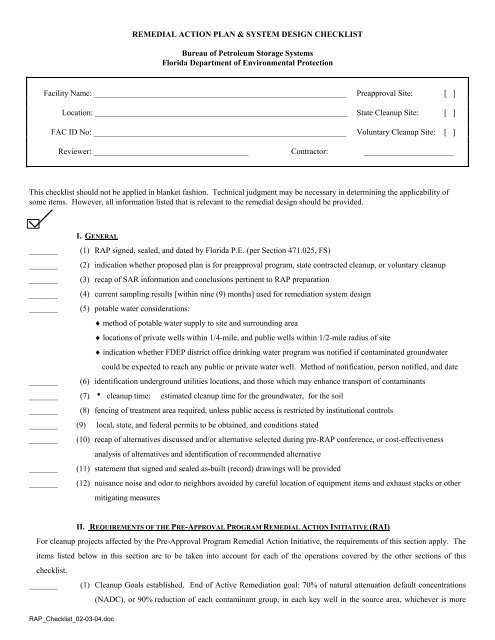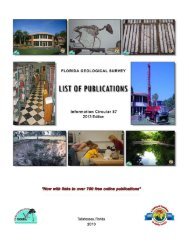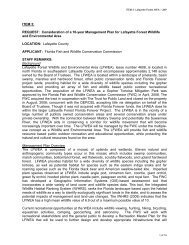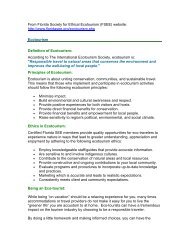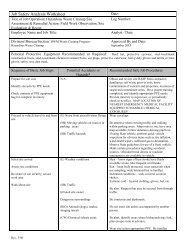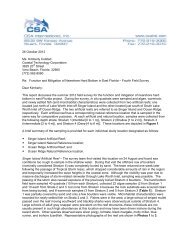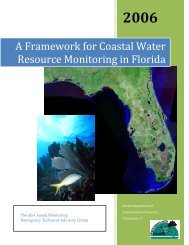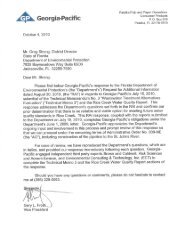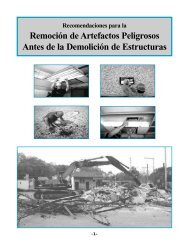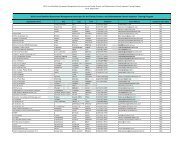Remedial Action Plan checklist - Florida Department of ...
Remedial Action Plan checklist - Florida Department of ...
Remedial Action Plan checklist - Florida Department of ...
You also want an ePaper? Increase the reach of your titles
YUMPU automatically turns print PDFs into web optimized ePapers that Google loves.
RAP_Checklist_02-03-04.doc<br />
REMEDIAL ACTION PLAN & SYSTEM DESIGN CHECKLIST<br />
Bureau <strong>of</strong> Petroleum Storage Systems<br />
<strong>Florida</strong> <strong>Department</strong> <strong>of</strong> Environmental Protection<br />
Facility Name: ______________________________________________________________ Preapproval Site: [ ]<br />
Location: ______________________________________________________________ State Cleanup Site: [ ]<br />
FAC ID No: ______________________________________________________________ Voluntary Cleanup Site: [ ]<br />
Reviewer: ______________________________________ Contractor: ______________________<br />
This <strong>checklist</strong> should not be applied in blanket fashion. Technical judgment may be necessary in determining the applicability <strong>of</strong><br />
some items. However, all information listed that is relevant to the remedial design should be provided.<br />
I. GENERAL<br />
_______ (1) RAP signed, sealed, and dated by <strong>Florida</strong> P.E. (per Section 471.025, FS)<br />
_______ (2) indication whether proposed plan is for preapproval program, state contracted cleanup, or voluntary cleanup<br />
_______ (3) recap <strong>of</strong> SAR information and conclusions pertinent to RAP preparation<br />
_______ (4) current sampling results [within nine (9) months] used for remediation system design<br />
_______ (5) potable water considerations:<br />
♦ method <strong>of</strong> potable water supply to site and surrounding area<br />
♦ locations <strong>of</strong> private wells within 1/4-mile, and public wells within 1/2-mile radius <strong>of</strong> site<br />
_______<br />
♦ indication whether FDEP district <strong>of</strong>fice drinking water program was notified if contaminated groundwater<br />
could be expected to reach any public or private water well. Method <strong>of</strong> notification, person notified, and date<br />
(6) identification underground utilities locations, and those which may enhance transport <strong>of</strong> contaminants<br />
_______ (7) h cleanup time: estimated cleanup time for the groundwater, for the soil<br />
_______ (8) fencing <strong>of</strong> treatment area required, unless public access is restricted by institutional controls<br />
_______ (9) local, state, and federal permits to be obtained, and conditions stated<br />
_______ (10) recap <strong>of</strong> alternatives discussed and/or alternative selected during pre-RAP conference, or cost-effectiveness<br />
analysis <strong>of</strong> alternatives and identification <strong>of</strong> recommended alternative<br />
_______ (11) statement that signed and sealed as-built (record) drawings will be provided<br />
_______ (12) nuisance noise and odor to neighbors avoided by careful location <strong>of</strong> equipment items and exhaust stacks or other<br />
mitigating measures<br />
II. REQUIREMENTS OF THE PRE-APPROVAL PROGRAM REMEDIAL ACTION INITIATIVE (RAI)<br />
For cleanup projects affected by the Pre-Approval Program <strong>Remedial</strong> <strong>Action</strong> Initiative, the requirements <strong>of</strong> this section apply. The<br />
items listed below in this section are to be taken into account for each <strong>of</strong> the operations covered by the other sections <strong>of</strong> this<br />
<strong>checklist</strong>.<br />
_______ (1) Cleanup Goals established. End <strong>of</strong> Active Remediation goal: 70% <strong>of</strong> natural attenuation default concentrations<br />
(NADC), or 90% reduction <strong>of</strong> each contaminant group, in each key well in the source area, whichever is more
REMEDIAL ACTION PLAN CHECKLIST Page 2<br />
RAP_Checklist_02-03-04.doc<br />
FAC ID No:___________________________________________<br />
stringent, in the specified time frame (typically one to four years). Longer cleanup times to achieve end <strong>of</strong> active<br />
remedial action goal require special justification.<br />
_______ (2) Pilot testing <strong>of</strong> the proposed remediation strategy is generally required. Exceptions require special justification.<br />
_______ (3) Remediation equipment must meet the specifications contained in the <strong>Remedial</strong> <strong>Action</strong> Initiative including<br />
reasonable safety factors.<br />
_______ (4) System designs includes adequate source area treatment wells, e.g. a safety factor <strong>of</strong> 2, and consideration <strong>of</strong> using<br />
parallel or zoned systems.<br />
_______ (5) Ultimate cleanup target levels need to be indicated, either (CTLs) <strong>of</strong> Chapter 62-770 for unconditional NFA, or<br />
Alternative CTLs for conditional NFA. For conditional NFA, owner’s acknowledgement <strong>of</strong> future institutional<br />
controls at cleanup completion should be documented<br />
_______ (6) End <strong>of</strong> Active Remediation to be followed by Natural Attenuation Monitoring. An evaluation <strong>of</strong> “time to switch”<br />
from active remedial action to Natural Attenuation Monitoring to reach ultimate cleanup target levels may be<br />
performed to allow for the continuation <strong>of</strong> active remedial action if justified.<br />
_______ (7) Milestones schedule must be included in RAP using the BPSS milestone model. The schedule must identify key<br />
wells, contaminants <strong>of</strong> concern, baseline contaminant concentrations, and time to reach the end <strong>of</strong> active remedial<br />
action. A linear concentration vs. time pr<strong>of</strong>ile shall apply to each contaminant group in each key well.<br />
_______ (8) Applicability <strong>of</strong> “difficult sites” evaluation procedures established (mandatory if post-assessment cleanup cost<br />
will likely exceed $500,000 or cleanup time will exceed 4 years). Some elements <strong>of</strong> the “difficult sites”<br />
evaluation procedures may be applicable to sites with cleanups, which will not exceed $500,000, or a 4 year<br />
cleanup time. If applicability established, FDEP PE must complete difficult sites <strong>checklist</strong> attached to May 21,<br />
2003 Difficult Sites memorandum.<br />
_______ (9) RAP must include a Construction <strong>Plan</strong> and a construction schedule.<br />
_______ (10) RAP must include a Startup Test <strong>Plan</strong>, and startup testing must be conducted in accordance with manufacturer’s<br />
recommendations.<br />
_______ (11) RAP must include a Preventative and Routine Maintenance <strong>Plan</strong> and <strong>checklist</strong>, a Repair Response <strong>Plan</strong> and<br />
maintenance visit schedule. The repair response plan must address sytem monitoring, equipmant operation and<br />
replacement part availability and supply.<br />
_______ (12) RAP must indicate that equipment will be UL approved (or equivalent) and will have a warranty<br />
_______ (13) Hour meters, flow meters, pressure gauges, and vacuum gauges specified for all critical components, including<br />
individual wells if necessary for optimization <strong>of</strong> system efficiency<br />
_______ (14) Autodialer system specified (telemetry may be specified with justification)<br />
_______ (16) Equipment items must be protected (covered or housed in a trailer).<br />
_______ (17) Specifications, and an Operations Manual must be provided to FDEP/LP, and a copy must be kept at the site.<br />
_______ (18) RAP specifies that Startup, Quarterlyand Annual Reports will be provided, and must include the information<br />
detailed in the RAI.<br />
III. FREE PRODUCT REMOVAL<br />
_______ (1) free product plume identification
REMEDIAL ACTION PLAN CHECKLIST Page 3<br />
_______ (2) description/design details <strong>of</strong> free product recovery system including:<br />
RAP_Checklist_02-03-04.doc<br />
FAC ID No:___________________________________________<br />
_______<br />
♦oil/water separator sizing calculations and detention time ♦ free product storage tank <strong>of</strong> adequate size<br />
(3) automated product pump shutdown for high level in product tank<br />
_______ (4) safety considerations: ♦ static electricity ♦ electrical & instruments per National Electrical Code<br />
_______ (5) proper disposal and safe handling <strong>of</strong> flammable free product recovered<br />
IV. SOIL REMEDIATION - GENERAL<br />
_______ (1) volume <strong>of</strong> contaminated soil<br />
_______ (2) recap <strong>of</strong> Source Removal activities and soil volume already excavated, if any<br />
_______ (3) indication that contaminated soil will be remediated, or provide rationale for 'no action'<br />
(4) soil cleanup target levels identified, extent <strong>of</strong> soil contamination should be delineated by use <strong>of</strong> both OVA<br />
screening results and laboratory analysis results<br />
(5) Use <strong>of</strong> Level I Risk Management Options for soil considered, if applicable, including SPLP, TRPH fractionation,<br />
and calculation <strong>of</strong> site specific SCTLs based on soil properties<br />
_______ (6) proper handling & treatment <strong>of</strong> excavated, contaminated soil, or proper handling & disposal <strong>of</strong> hazardous soil<br />
(e.g., ignitable, corrosive, reactive, toxic, or petroleum refining waste)<br />
V. LAND FARMING OF SOIL<br />
_______ (1) adequate surface area available (______ sq ft) to spread soil 6 to 12 inches thick<br />
_______ (2) location <strong>of</strong> land farming operation<br />
_______ (3) land farming area is flat (less than 5% slope)<br />
_______ (4) impermeable base provided. Type: _______________________<br />
_______ (5) surface water run<strong>of</strong>f controls provided<br />
_______ (6) groundwater monitoring plan proposed if land farm is outside <strong>of</strong> immediate contamination area<br />
_______ (7) frequency <strong>of</strong> tilling provided<br />
_______ (8) frequency and details <strong>of</strong> nutrient application or other enhancements provided (if proposed)<br />
_______ (9) soil sampling frequency and sampling methods provided<br />
_______ (10) potential for land farm causing nuisance conditions evaluated<br />
(11) underlying soil and groundwater monitoring procedures provided and acceptable<br />
_______ (12) land farming will be continued until the contaminants <strong>of</strong> concern meet soil cleanup target levels<br />
_______ (13) cost-effectiveness<br />
_______ (14) ultimate disposition <strong>of</strong> soil discussed<br />
_______ (15) need to fence land farm area considered<br />
VI. LANDFILLING OF SOIL<br />
_______ (1) landfill lined and permitted by FDEP<br />
_______ (2) name and location <strong>of</strong> landfill provided along with conditions <strong>of</strong> acceptance<br />
_______ (3) cost-effectiveness
REMEDIAL ACTION PLAN CHECKLIST Page 4<br />
RAP_Checklist_02-03-04.doc<br />
FAC ID No:___________________________________________<br />
_______ (4) For out-<strong>of</strong>-state landfill disposal, evidence provided that petroleum contaminated soil disposal in the landfill<br />
complies with the landfill regulations <strong>of</strong> the other state.<br />
VII. SOIL THERMAL TREATMENT<br />
_______ (1) name and location <strong>of</strong> thermal treatment facility provided<br />
_______ (2) facility is permitted for thermal treatment <strong>of</strong> petroleum contaminated soil<br />
_______ (3) pretreatment soil sample analyses<br />
_______ (4) cost-effectiveness<br />
VIII. COMMERCIAL BIOREMEDIATION OF SOIL<br />
_______ (1) name and location <strong>of</strong> bioremediation facility provided<br />
_______ (2) facility is permitted for bioremediation <strong>of</strong> petroleum contaminated soil<br />
_______ (3) pretreatment soil sample analyses<br />
_______ (4) cost-effectiveness<br />
IX. IN SITU BIOVENTING OF SOIL<br />
_______ (1) soil cleanup criteria identification<br />
_______ (2) estimated mass <strong>of</strong> contaminants <strong>of</strong> concern in the vadose zone<br />
_______ (3) recap <strong>of</strong> information and data from pilot study that is pertinent full-scale system design<br />
_______ (4) layout<br />
♦ well type — vertical or horizontal ♦ well construction details<br />
♦ location <strong>of</strong> air injection and air extraction wells with respect to contaminated soil plume location and depth<br />
_______<br />
♦ location and depth <strong>of</strong> soil gas monitoring probes with respect to contaminated soil plume and the air injection and<br />
extraction wells<br />
(5) design and operating parameters, equipment sizing calculations, mechanical details<br />
_______ (6) instruments, controls, gauges, and valves<br />
_______ (7) monitoring plan: CO2; pertinent bioremediation parameters; contaminants <strong>of</strong> concern<br />
_______ (8) air emissions<br />
♦ demonstration that primary mechanism <strong>of</strong> remediation will be bioremediation and not volatilization. Air flow<br />
rates will be limited based on oxygen demand for bioremediation as demonstrated by pilot study results<br />
♦ evaluation <strong>of</strong> methods for <strong>of</strong>f-gas treatment if pilot test indicated that a significant amount <strong>of</strong> hydrocarbon<br />
volatilization will occur<br />
X. SOIL VAPOR EXTRACTION<br />
_______ (1) prerequisites: ♦ relatively permeable soil ♦ depth to groundwater > 3 ft ♦ relatively volatile contaminants<br />
_______ (2) recap <strong>of</strong> information and data from pilot study that is pertinent to full-scale system design:<br />
(3) full-scale design
REMEDIAL ACTION PLAN CHECKLIST Page 5<br />
RAP_Checklist_02-03-04.doc<br />
FAC ID No:___________________________________________<br />
_______ (a) layout and spacing <strong>of</strong> SVE wells (consideration given to radius <strong>of</strong> influence and overlapping <strong>of</strong> radii)<br />
_______ (b) vapor extraction well(s)<br />
♦ no. <strong>of</strong> wells ♦ cfm each well ♦ total cfm<br />
details<br />
♦ well type (vertical or horizontal) ♦ well construction<br />
_______ (c) pneumatic design<br />
♦ operating vacuum @ wellhead(s) (inches <strong>of</strong> water)<br />
♦ piping system friction losses<br />
♦ pump motor (hp) based on system losses plus required vacuum at wellhead<br />
_______ (d) vacuum source type: regenerative blower; positive displacement vacuum pump; other<br />
♦ design specifications: cfm @ inches <strong>of</strong> water; operating cfm @ inches <strong>of</strong> water<br />
♦ mfr; model; motor hp; rpm; performance curves<br />
♦ nonferrous materials <strong>of</strong> construction and/or assembly to minimize potential for sparking and friction<br />
_______<br />
♦ explosion-pro<strong>of</strong> motor<br />
(e) moisture separator/condensation trap (“knock out pot”) prior to inlet <strong>of</strong> vacuum pump<br />
_______ (f) surface sealing provided for vacuum extraction, or existing concrete or asphalt adequate<br />
_______ (g) safety<br />
♦ system operation at approximately 25% <strong>of</strong> Lower Explosive Limit (LEL)<br />
_______<br />
♦ bleed valve provided to control flammable vapor concentrations<br />
(h) instrumentation, gauges, and appurtenances<br />
_______ (i) air emissions control (general)<br />
♦ method <strong>of</strong> <strong>of</strong>f-gas treatment to be provided during first month <strong>of</strong> system operation (provide details in Section X<br />
or XI for carbon adsorption or thermal oxidation <strong>of</strong> <strong>of</strong>f-gas, or provide details <strong>of</strong> an alternative method)<br />
________ (j) system monitoring<br />
♦ sample and analyze air emissions for total petroleum hydrocarbons, weekly for first month, monthly for next<br />
two months, quarterly thereafter<br />
♦ vacuum measurement locations (suggestion: use monitor wells at various radial distances from extraction<br />
wells)<br />
♦ acknowledge that air emission controls must be provided for at least first 30 days, but may have to be<br />
continued longer until petroleum hydrocarbon emissions to the atmosphere are less than 13.7 lbs/day<br />
_______<br />
XI. VAPOR-PHASE CARBON ADSORPTION (for control <strong>of</strong> air emissions)<br />
(1) recap <strong>of</strong> information and data from pilot study that is pertinent to full-scale system design, if a pilot was conducted<br />
_______ (2) cost-effectiveness evaluation in comparison to other alternatives for control <strong>of</strong> air emissions<br />
_______ (3) mechanical details, sizing calculations, and operating parameters<br />
_______ (4) instrumentation, controls, gauges, sampling and valves<br />
_______ (5) safety<br />
♦ operation <strong>of</strong> system below Lower Explosive Limit (LEL) for type <strong>of</strong> vapors being handled
REMEDIAL ACTION PLAN CHECKLIST Page 6<br />
RAP_Checklist_02-03-04.doc<br />
FAC ID No:___________________________________________<br />
♦ observance <strong>of</strong> appropriate requirements in Series 500 articles <strong>of</strong> the National Electrical Code — equipment shall<br />
meet either Class I, Group D, Division 1 or Class I, Group D, Division 2 hazardous area requirements, whichever<br />
is applicable, when an equipment item is located in a hazardous area as defined by the code<br />
XII. THERMAL/CATALYTIC OXIDATION (for control <strong>of</strong> air emissions)<br />
_______ (1) cost-effectiveness evaluation in comparison to other alternatives for control <strong>of</strong> air emissions<br />
_______ (2) mechanical details, equipment sizing calculations, and operating parameters<br />
_______ (3) instrumentation, controls, gauges, and valves. [schematic or mobile unit manufacturer's drawings indicating<br />
instrumentation, controls, gauges, and valves for all process streams (contaminant-laden influent, fuel gas, and<br />
combustion air)]<br />
_______ (4) safety considerations include, but are not limited to:<br />
♦ bleed valve or dilution control valve to maintain influent flammable vapor concentration at 25% <strong>of</strong> the Lower<br />
Explosive Limit (LEL)<br />
♦ air purge prior to re-ignition<br />
♦ observance <strong>of</strong> appropriate requirements in Series 500 articles <strong>of</strong> the National Electrical Code — equipment shall<br />
meet either Class I, Group D, Division 1 or Class I, Group D, Division 2 hazardous area requirements, whichever<br />
is applicable, when located in a hazardous area as defined by the code<br />
♦ use <strong>of</strong> thermal or catalytic oxidizers which meet appropriate fire codes for handling natural or propane gas and<br />
prevention <strong>of</strong> furnace explosions — National Fire Protection Association, Industrial Risk Insurer’s, Factory<br />
Mutual, etc. Some <strong>of</strong> the most important safety shutdowns for gas-fired burners occur upon: high gas pressure;<br />
low gas pressure; loss <strong>of</strong> combustion supply air; loss or failure to establish flame; loss <strong>of</strong> control system actuating<br />
energy; power failure<br />
XIII. GROUNDWATER EXTRACTION<br />
_______ (1) feasibility <strong>of</strong> using existing on-site wells for groundwater extraction considered<br />
_______ (2) recovery well summary<br />
♦ recovery well or trench location(s) and construction details included (diameter, screen length, grout, etc.)<br />
_______<br />
♦ recovery well depth and screen length appropriate for depth <strong>of</strong> contamination<br />
(3) predicted horizontal and vertical area <strong>of</strong> influence provided<br />
_______ (4) expected drawdown in recovery well or trench<br />
_______ (5) consideration <strong>of</strong> multiple well configuration to minimize drawdown<br />
_______ (6) groundwater pump performance requirements, sizing, and description<br />
♦ hydraulic design considerations (friction losses and suction lift)<br />
♦ pump performance curve or information provided (flow rate vs. pressure)<br />
_______<br />
♦ pump manufacturer, model; hp, rpm<br />
(7) automated well level controls provided for stopping/starting groundwater pump(s)<br />
_______ (8) totalizing flowmeter installed on influent line from each groundwater recovery pump<br />
_______ (9) check valve provided on pump discharge piping if not integral to pump
REMEDIAL ACTION PLAN CHECKLIST Page 7<br />
_______ (10) shut<strong>of</strong>f/throttling valve provided on pump discharge piping<br />
RAP_Checklist_02-03-04.doc<br />
FAC ID No:___________________________________________<br />
XIV. GROUNDWATER TREATMENT SYSTEM - GENERAL<br />
_______ (1) influent concentrations for each contaminant <strong>of</strong> concern, for design <strong>of</strong> treatment system, based on either actual<br />
dynamic pump test sample, weighted averaging procedure, or other reasonable assumption<br />
_______ (2) feasibility & cost-effectiveness <strong>of</strong> direct discharge <strong>of</strong> recovered contaminated groundwater to sewer treatment<br />
plant, instead <strong>of</strong> onsite treatment<br />
_______ (3) site piping summary<br />
♦ schematics <strong>of</strong> all treatment components, piping, valves, controls and appurtenances provided<br />
♦ influent and effluent sampling ports provided<br />
♦ piping type and size provided<br />
_______ (4) fouling & scaling considerations<br />
♦ whether control <strong>of</strong> iron fouling is necessary, either by filtration <strong>of</strong> influent to remove particulately-bound iron,<br />
and/or by removal or sequestering <strong>of</strong> dissolved iron to prevent precipitation in process equipment items<br />
♦ whether pretreatment or other measures necessary to prevent precipitation <strong>of</strong> calcium carbonate (Langelier Index)<br />
♦ whether pretreatment or scheduled O&M measures will be needed for control <strong>of</strong> bi<strong>of</strong>ouling<br />
XV. AIR STRIPPING TREATMENT PROCESS<br />
_______ (1) packed tower<br />
♦ type, size, and surface area <strong>of</strong> packing<br />
♦ design and operating parameters, sizing calculations, mechanical details (tower height; packing type, height, surface<br />
area; air/water ratio; pressure drop; blower type, model, hp; mist eliminator; etc.)<br />
_______ (2) diffused aerator (tank type)<br />
♦ design and operating parameters, sizing calculations, mechanical details (tank volume; contact time; air flow rate;<br />
pressure drop; removal efficiency <strong>of</strong> contaminants <strong>of</strong> concern; blower type, model, hp; etc.)<br />
_______ (3) low pr<strong>of</strong>ile air stripper<br />
♦ design and operating parameters, sizing calculations, mechanical details (number <strong>of</strong> trays; water flow rate; air flow<br />
rate; air/water ratio; pressure drop; blower type, model, hp; mist eliminator)<br />
_______ (4) general<br />
♦ instrumentation, controls, gauges and valves<br />
♦ air emissions calculations; emissions stack height<br />
♦ equipment description if emissions treatment necessary<br />
♦ automated recovery well shutdown when blower failure occurs<br />
♦ sampling <strong>of</strong> effluent, daily for first three days, monthly for next two months, quarterly thereafter<br />
XVI. LIQUID-PHASE CARBON ADSORPTION<br />
_______ (1) recap <strong>of</strong> information and data from pilot study that is pertinent to full-scale system design, if a pilot was conducted<br />
_______ (2) indication whether adsorption is for primary treatment <strong>of</strong> groundwater or polishing <strong>of</strong> effluent
REMEDIAL ACTION PLAN CHECKLIST Page 8<br />
RAP_Checklist_02-03-04.doc<br />
FAC ID No:___________________________________________<br />
_______ (3) carbon specifications<br />
_______ (4) carbon unit(s) sizing calculations (carbon usage rate, contact time, pressure losses) design assumptions<br />
_______ (5) TOC in groundwater determined and effect on carbon usage considered<br />
_______ (6) need for sand filter or cartridge unit prior to carbon unit considered<br />
_______ (7) pressure gauge and pressure relief valve provided on carbon (and sand) filter<br />
_______ (8) carbon disposal and replacement method<br />
_______ (9) series configuration <strong>of</strong> carbon units considered to allow for maximum carbon utilization and prevention <strong>of</strong><br />
contaminant breakthrough to system effluent<br />
_______ (10) automated recovery well shutdown if primary carbon unit pressure too high<br />
_______ (11) schedule for sampling between and after carbon adsorption units<br />
XVII. IN SITU AIR SPARGING OF GROUNDWATER<br />
_______ (1) prerequisites<br />
♦ no or little free product which could spread via sparge turbulence, or prolong sparging<br />
♦ volatile (C3-C10) petroleum fractions with Henry’s Constant ≥ 0.00001 atm * m3 /mol (approx. rule <strong>of</strong> thumb,<br />
unless biosparging is proposed)<br />
♦ no high concentrations <strong>of</strong> metals (iron, magnesium) to form oxides which plug aquifer or well screens, or high<br />
concentrations <strong>of</strong> dissolved calcium, which could react with CO2 in air to clog aquifer w/calcium carbonate<br />
_______ (2) recap <strong>of</strong> information and data from pilot study that is pertinent to full-scale system design<br />
(3) full-scale design<br />
_______ (a) groundwater contamination plume coverage<br />
♦ location(s) and radius <strong>of</strong> influence for full-scale air injection well(s)<br />
♦ adequate coverage by overlapping radii <strong>of</strong> influence if multiple well system<br />
_______ (b) air injection well(s): no. <strong>of</strong> wells; well design; operating air pressure at wellheads; cfm each well; total cfm<br />
_________________<br />
_______ (c) avoidance <strong>of</strong> long screen allowing air to diffuse at top portion only, where air flow resistance is least (typ<br />
screen is 1 to 3 ft long)<br />
_______ (d) well depth and screened interval (or depth <strong>of</strong> sparge tip) appropriate w/respect to depth <strong>of</strong> contamination<br />
_______ (e) vapor extraction well(s) in conjunction w/sparging situated properly to recover volatiles and prevent their<br />
release to atmosphere<br />
♦ injection cfm <strong>of</strong> air typically 20 to 80% <strong>of</strong> vapor extraction cfm (0.2 to 0.8)<br />
♦ automatic shutdown <strong>of</strong> air injection upon loss <strong>of</strong>, or low, vapor extraction system vacuum, or failure <strong>of</strong><br />
vacuum pump motor, in order to prevent air emissions<br />
♦ adequate and cost-effective treatment <strong>of</strong> vapor extraction system <strong>of</strong>f-gas proposed to prevent air emissions<br />
_______ (f) compressor<br />
♦ design: cfm @ psig; operating cfm @ psig
REMEDIAL ACTION PLAN CHECKLIST Page 9<br />
RAP_Checklist_02-03-04.doc<br />
FAC ID No:___________________________________________<br />
♦ type; mfr; model; motor hp; rpm; performance curves; air filter at compressor inlet; oil trap or oil-free<br />
compressor to avoid introducing more contamination to aquifer<br />
_______ (g) safety: pressure relief valve at discharge <strong>of</strong> compressor and/or high pressure switch for automatic shutdown<br />
_______ (h) instrumentation and gauges: pressure indicating gauges at each sparging well<br />
_______ (i) air flow control: shut<strong>of</strong>f/throttling valve at each well; other flow control device or method<br />
XVIII. IN SITU BIOREMEDIATION<br />
_______ (1) general:<br />
♦ media to be remediated: groundwater; soil<br />
♦ application method: direct-injection; recirculating/re-injection type system; addition to excavation pit<br />
♦ aerobic or anaerobic<br />
♦ stimulation <strong>of</strong> indigenous microorganisms or addition <strong>of</strong> microorganisms<br />
_______ (2) recap <strong>of</strong> information and data from pilot study that is pertinent to full-scale system design<br />
_______ (3) design and operating parameters (e.g.: injection well construction details; layout and spacing <strong>of</strong> wells<br />
commensurate with injection radius <strong>of</strong> influence for adequate horizontal coverage; screened interval <strong>of</strong> injection<br />
wells commensurate with vertical extent <strong>of</strong> contamination for adequate vertical coverage; injection pump<br />
develops adequate pressure and flow rate for injection , for the site-specific conditions.)<br />
_______ (4) dosage (<strong>of</strong> nutrients and/or microorganisms, per pound <strong>of</strong> hydrocarbon contaminants to be biodegraded) ( Some<br />
bioremediation products may express dosage as a required amount per cubic yard <strong>of</strong> contaminated media.)<br />
_______ (5) RAP (or RAP Mod) must contain the necessary underground injection control information required by Chapter<br />
62-528 FAC. [That is, the RAP must contain enough information for a state or local program reviewer to fill out<br />
the 2-page UIC notification memorandum titled “Proposed Injection Well(s) for In Situ Aquifer Remediation at a<br />
Petroleum <strong>Remedial</strong> <strong>Action</strong> Site”.] This includes the following information:<br />
♦ chemical analysis (composition) <strong>of</strong> the fluid to be injected. Note: The injected fluid must meet primary and<br />
secondary drinking water standards <strong>of</strong> Chapter 62-550, FAC, and the minimum groundwater criteria <strong>of</strong> Chapters<br />
62-520 and 62-777 FAC, otherwise Rule 62-522.300(2)(c) may apply and/or a zone <strong>of</strong> discharge variance may be<br />
necessary.<br />
♦ no. <strong>of</strong> injection wells ♦ no. <strong>of</strong> injection events ♦ injection volume per well per injection event<br />
♦ total injection volume (i.e. the total for all injection wells, all injection events)<br />
_______ (7) anticipated schedule <strong>of</strong> injection events for nutrients and/or microorganisms (i.e. the timing and frequency <strong>of</strong><br />
injections over the life <strong>of</strong> the project)<br />
_______ (7) provide additional oxygen, if necessary, if the bioremediation is aerobic and site’s groundwater is lacking in<br />
dissolved oxygen. (method by which additional oxygen will be delivered.; provide design details if method <strong>of</strong><br />
delivery is mechanical, e.g. air sparge, O2 injection, iSOC, etc.; provide chemical information if oxygen is<br />
supplied chemically: e.g. magnesium peroxide, calcium peroxide, hydrogen peroxide, etc.)<br />
_______ (9) ♦ sampling plan includes not just the analysis <strong>of</strong> samples for petroleum contaminants <strong>of</strong> concern at a site, but also<br />
analyses necessary for any <strong>of</strong> the following that apply: compliance with the underground injection control
REMEDIAL ACTION PLAN CHECKLIST Page 10<br />
RAP_Checklist_02-03-04.doc<br />
FAC ID No:___________________________________________<br />
regulations <strong>of</strong> Chapter 62-528; compliance with Rule 62-522.300(2)(c); and compliance with the terms <strong>of</strong> an<br />
injection zone <strong>of</strong> discharge variance. Also, analysis for more than just the reagents may be necessary,<br />
depending on the situation. In some cases, if there are environmental or toxicological concerns, it may be<br />
necessary to include analysis for intermediate degradation products <strong>of</strong> the reagents, or intermediate by-products<br />
formed by the interaction <strong>of</strong> those reagents with the petroleum contaminants <strong>of</strong> concern at a site.<br />
♦ other samples and operating parameter measurements for a bioremediation project may inlcude, but are not<br />
necessarily limited to the following: pH, DO, ORP, N, P, Temperature, TOC, Alkalinity., microbe counts<br />
XIX. LEAD (this section can also be adapted to other heavy metals if necessary)<br />
_______ (1) discussion <strong>of</strong> area(s) where groundwater lead concentration exceeds 15 ppb<br />
_______ (2) lead concentrations (ppb): unfiltered (____); filtered (____); background (____)<br />
_______ (3) proposal for lead removal by filtration if unfiltered sample is greater than 15 ppb and filtered sample is less<br />
than 15 ppb<br />
_______ (4) method <strong>of</strong> lead removal, including pertinent design calculations<br />
_______ (5) if lead (or other heavy metals) will not be removed by filtration, then provide details <strong>of</strong> proposed treatment<br />
XX. INFILTRATION GALLERY<br />
_______ (1) recap <strong>of</strong> field percolation test results (preferably with double-ring infiltrometer)<br />
_______ (2) infiltration gallery construction details and location (upgradient location if site layout allows)<br />
_______ (3) gallery calculations/assumptions with mounding analysis<br />
_______ (4) piezometer and cleanout pipe in gallery<br />
_______ (5) geotextile filter fabric to be installed around and above gallery<br />
_______ (6) discussion or modeling <strong>of</strong> gallery for effect on plume migration<br />
_______<br />
XXI. INJECTION WELL (for effluent disposal)<br />
(1) discussion <strong>of</strong> injection zone and relevant lithology information<br />
_______ (2) recap <strong>of</strong> information and data from pilot study that is pertinent to full-scale system design, if a pilot was<br />
conducted<br />
_______ (3) injection well location and construction details<br />
_______ (4) screened interval appropriate<br />
_______ (5) effluent discharge pump adequately sized for required injection flow rate and pressure<br />
_______ (6) carbon polishing unit (or equivalent)<br />
_______ (6) air release valve at highest point <strong>of</strong> effluent discharge piping<br />
_______ (7) injection rate (well hydraulics) calculations<br />
_______ (8) Underground Injection Control (UIC) inventory information provided. (RAP or RAP Mod must contain enough<br />
information for a technical reviewer to complete the 2-page UIC effluent injection notification.)<br />
_______ (9) evaluation <strong>of</strong> injection well’s effect on potable wells and plume migration
REMEDIAL ACTION PLAN CHECKLIST Page 11<br />
RAP_Checklist_02-03-04.doc<br />
XXII. ALTERNATIVE EFFLUENT DISPOSAL METHODS<br />
FAC ID No:___________________________________________<br />
_______ (1) cost-effectiveness comparison <strong>of</strong> alternatives (including general permit fee <strong>of</strong> $2,500 per year in the cost estimate<br />
for NPDES disposal, if it is one <strong>of</strong> the alternatives being compared)<br />
_______ (2) for surface water discharge<br />
♦ conditions for NPDES general permit met<br />
_______<br />
♦ indication that notice <strong>of</strong> intent for NPDES permit will be submitted after RAP approval<br />
(3) if applicable, consumptive use permit obtained from Water Management District<br />
_______ (4) approval from municipality for sewer discharge, and conditions and effluent standards to be met<br />
_______ (5) applicable permits for stormwater discharge<br />
XXIII. SAMPLING REQUIREMENTS<br />
_______ (1) designated / key monitoring wells and frequency <strong>of</strong> their sampling per 62-770.700, FAC<br />
_______ (2) analysis <strong>of</strong> designated / key monitoring well samples for appropriate contaminants <strong>of</strong> concern for the site<br />
_______ (3) sampling <strong>of</strong> influent from recovery well(s); daily first 3 days, monthly next 2 months, quarterly thereafter<br />
_______ (4) sampling <strong>of</strong> system effluent, daily for first three days, monthly for next two months, quarterly thereafter<br />
_______ (5) water level data collected at same time & frequency <strong>of</strong> monitoring well and recovery well sampling<br />
XXIV. IN SITU CHEMICAL OXIDATION<br />
_______ (1) media to be remediated: groundwater; soil<br />
_______ (2) recap <strong>of</strong> information and data from pilot study that is pertinent to full-scale system design<br />
_______ (3) design and operating parameters (e.g.: injection well construction details; layout and spacing <strong>of</strong> wells<br />
commensurate with injection radius <strong>of</strong> influence for adequate horizontal coverage; screened interval <strong>of</strong> injection<br />
wells commensurate with vertical extent <strong>of</strong> contamination for adequate vertical coverage; flow rates;<br />
temperatures; pressures; pH; concentrations, etc.)<br />
_______ (4) amount <strong>of</strong> reagents required per pound <strong>of</strong> hydrocarbons to be destroyed (theoretical amount, actual amount)<br />
_______ (5) RAP (or RAP Mod) must contain the necessary underground injection control information required by Chapter<br />
62-528 FAC. [That is, the RAP must contain enough information for a state or local program reviewer to fill out<br />
the 2-page UIC notification memorandum titled “Proposed Injection Well(s) for In Situ Aquifer Remediation at a<br />
Petroleum <strong>Remedial</strong> <strong>Action</strong> Site”.] This includes the following information:<br />
♦ chemical analysis (composition) <strong>of</strong> the fluid to be injected. Note: The injected fluid must meet primary and<br />
secondary drinking water standards <strong>of</strong> Chapter 62-550, FAC, and the minimum groundwater criteria <strong>of</strong> Chapters<br />
62-520 and 62-777 FAC, otherwise Rule 62-522.300(2)(c) may apply and/or a zone <strong>of</strong> discharge variance may be<br />
necessary.<br />
♦ no. <strong>of</strong> injection wells ♦ no. <strong>of</strong> injection events ♦ injection volume per well per injection event<br />
♦ total injection volume (i.e. the total for all injection wells, all injection events)<br />
_______ (6) ♦ sampling plan includes not just the analysis <strong>of</strong> samples for petroleum contaminants <strong>of</strong> concern at a site, but also<br />
analyses necessary for any <strong>of</strong> the following that apply: compliance with the underground injection control<br />
regulations <strong>of</strong> Chapter 62-528; compliance with Rule 62-522.300(2)(c); and compliance with the terms <strong>of</strong> an
REMEDIAL ACTION PLAN CHECKLIST Page 12<br />
RAP_Checklist_02-03-04.doc<br />
FAC ID No:___________________________________________<br />
injection zone <strong>of</strong> discharge variance. Also, analysis for more than just the reagents may be necessary,<br />
depending on the situation. In some cases, if there are environmental or toxicological concerns, it may be<br />
necessary to include analysis for intermediate degradation products <strong>of</strong> the reagents, or intermediate by-products<br />
formed by the interaction <strong>of</strong> those reagents with the petroleum contaminants <strong>of</strong> concern at a site.<br />
♦ other samples and operating parameter measurements for a chemical oxidation project may inlcude, but are not<br />
necessarily limited to the following: pH, DO, ORP, Temperature, and Alkalinity.<br />
_______ (7) anticipated schedule <strong>of</strong> injection events for reagents (i.e. the timing and frequency <strong>of</strong> injections over the life <strong>of</strong><br />
the project)<br />
_______ (8) safety (items applicable to fire, explosion, toxicological and safe handling <strong>of</strong> chemicals may include, but are not<br />
necessarily limited to those listed below)<br />
♦ material safety data sheets, toxicity, or other information pertinent to the chemicals and catalysts involved<br />
♦ safe handling <strong>of</strong> chemicals: avoidance <strong>of</strong> mixing, premature mixing, or improper storage <strong>of</strong> incompatible<br />
chemicals<br />
♦ Lower Explosive Level (LEL) considerations<br />
♦ potential for vapor migration, either passively or by convection, or driven by air or other gases used, or<br />
generated by the heat <strong>of</strong> exothermic chemical reactions or the vaporization <strong>of</strong> free product by such heat<br />
♦ the minimum tolerable distance between underground storage tanks and product piping and any in situ<br />
heat-generating process<br />
♦ the need replace the flammable contents <strong>of</strong> petroleum storage tanks and their associated piping with<br />
non-flammable inerts such as nitrogen or carbon dioxide, in order to reduce risk <strong>of</strong> fire and explosion.<br />
♦ observance <strong>of</strong> National Electrical Code (typically Series 500 articles for Class I, Group D, Division 1 or 2<br />
hazardous area requirements) (for electrical equipment items located in a hazardous area)<br />
♦ appropriate chemical-resistant and/or spark-resistant materials <strong>of</strong> construction for equipment items<br />
♦ personal protection <strong>of</strong> workers<br />
♦ safety considerations regarding neighbors and passersby


